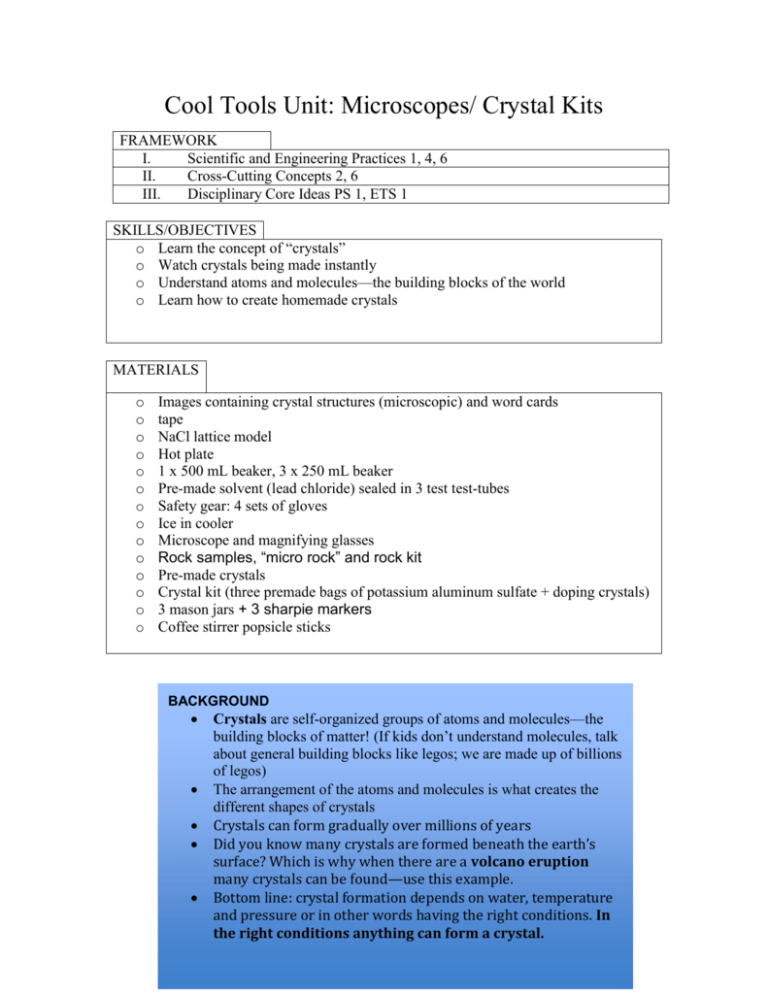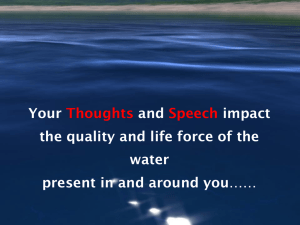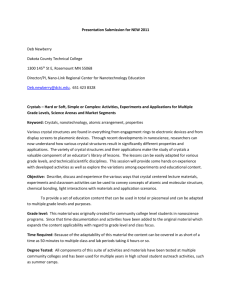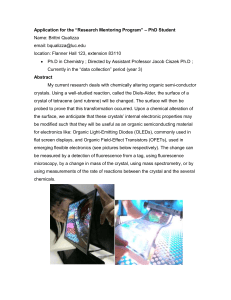Cool Tools Unit-Final - Wesleyan Science Outreach
advertisement

Cool Tools Unit: Microscopes/ Crystal Kits FRAMEWORK I. Scientific and Engineering Practices 1, 4, 6 II. Cross-Cutting Concepts 2, 6 III. Disciplinary Core Ideas PS 1, ETS 1 SKILLS/OBJECTIVES o Learn the concept of “crystals” o Watch crystals being made instantly o Understand atoms and molecules—the building blocks of the world o Learn how to create homemade crystals MATERIALS o o o o o o o o o o o o o o Images containing crystal structures (microscopic) and word cards tape NaCl lattice model Hot plate 1 x 500 mL beaker, 3 x 250 mL beaker Pre-made solvent (lead chloride) sealed in 3 test test-tubes Safety gear: 4 sets of gloves Ice in cooler Microscope and magnifying glasses Rock samples, “micro rock” and rock kit Pre-made crystals Crystal kit (three premade bags of potassium aluminum sulfate + doping crystals) 3 mason jars + 3 sharpie markers Coffee stirrer popsicle sticks BACKGROUND Crystals are self-organized groups of atoms and molecules—the building blocks of matter! (If kids don’t understand molecules, talk about general building blocks like legos; we are made up of billions of legos) The arrangement of the atoms and molecules is what creates the different shapes of crystals Crystals can form gradually over millions of years Did you know many crystals are formed beneath the earth’s surface? Which is why when there are a volcano eruption many crystals can be found—use this example. Bottom line: crystal formation depends on water, temperature and pressure or in other words having the right conditions. In the right conditions anything can form a crystal. Activity # 1 Materials Which is what? o Various Crystal images o Word cards for naming o Tape o -NaCl lattice model Worksheet No NOTE: Begin heating test tubes in water for Activity 2 immediately upon arrival Explain what crystals are—solid structures that form cool shapes based on their molecular (or “building block”) structures. See “Background” for more explanations and be sure to include volcanoe example. While doing warmup, someone else put up images of microscopic crystals on a wall with tape. How are they formed? - Takes either a few minutes or thousands of years to form. However, the ones we can see take longer periods of time. Who likes salt on their french fries? Salt is a very simple crystal made up of two types (Na and Cl) of atoms. Show salt lattice model (simple crystal) and explain the building block concept. Begin interactive activity and hand out word cards to each kid or pair. Hold a competition: Have them match the image to the item Activity # 2 Materials Heating Freeze o Hot plate o 3 test tubes with premade solvent o 500 mL heating beaker o 3 x 250 mL beakers with ice o magnifying glass Worksheet No Heat the three test tubes in a beaker of hot to boiling water until the solids totally dissolve. Swirl to aid effort. By the time this activity starts, the solids should be totally dissolved. Divide kids into three groups with a leader supervising each. Hand out magnifying glasses. Have the kids guess what would happen when the solution is put on ice Once groups are formed and students are ready, give each leader a test tube and a 250 ml beaker of ice. Have group leaders put tubes in the ice until crystals start forming—this will happen quickly so make sure everyone is ready. Once they begin crystalizing pull out and let everyone look with magnifying glasses. Explain why the crystal is formed - water, temperature and pressure effect how crystals are formed (e.g. diamonds are formed at very high temperature and pressure. Use analogy of volcano—the hot plate being the volcano—and the cooling crystals is the lava that forms rocks. Also try analogy of a flower - flowers need a certain amount of sunlight, nutrients and water to grow. Crystals also have their own requirements to grow. Activity # 3 Materials Look at microscopic crystals in real life! o 1 microscope o micro rock crystal sample o rock kit o magnifying glasses Worksheet No Boil water (maximum capacity) using kettle for activity 4 while this is going on Set up Microscope station so that the sample (labeled “micro rock”) is generally in focus. Set up other rocks on a table with magnifying glasses. While kids examine materials, explain how the structure of the crystals are influenced by atoms and molecules—building blocks. Activity # 4 Materials Worksheet Make your own crystal o Crystal kit o Mason jars o Kettle o Coffee stirrers o sharpies No Tell kids they are going to make their own crystals and explain that it will take a few days to fully form. Divide kids into three groups to prep for an activity. Show them an example of pre-made crystal in the salsa jar. In each group fill a mason jar with hot water and one pack of crystal powder. Stir to dissolve with provided coffee sticks and put lid back on. Mark lid with a group name (have the kids come up with it). Use provided sharpie. Please leave in a safe corner of the class where kids can observe throughout the week. Make a competition—who’s will be the biggest? CONCLUSIONS We live in a world of atoms and molecules Remember that there are crystals all around us They come all shapes and sizes Remember to check on the crystals everyday to see how much they have grown







